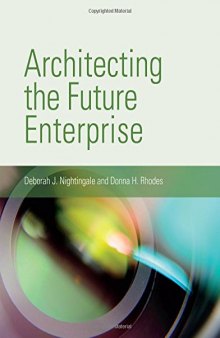 جزییات کتاب
جزییات کتاب
معماری سازمانی رویکردی جامع و یکپارچه است که جنبهها و عناصر مختلف سازمان (سیستم) را با نگاه مهندسی تفکیک و تحلیل مینماید و شامل مجموعه مستندات، مدلها، استانداردها و اقدامات اجرایی برای تحول از وضعیت موجود به وضعیت مطلوب با محوریت فناوری اطلاعات است که در قالب یک طرح مشخص اجرا شده و سپس به صورت مداوم توسعه و بروزرسانی میشود.
Every enterprise evolves continuously, driven by changing needs or new opportunities. Most often this happens gradually, with small adjustments to strategy, organization, processes, or infrastructure. But sometimes enterprises need to go beyond minor fixes and transform themselves, in response to a disruptive event or dramatically changing circumstances -- a merger, for example, or a new competitor. In this book, enterprise architecting experts Deborah Nightingale and Donna Rhodes offer a framework for enterprise transformation. Successful transformation, they believe, starts with a holistic approach, taking into consideration all facets of the enterprise and its environment rather than focusing solely on one factor -- information technology, for example, or organizational structure. This is architecting the future enterprise: creating a blueprint for what the enterprise will look like after the transformation.Nightingale and Rhodes introduce the ARIES (Architecting Innovative Enterprise Strategy) framework, including a ten enterprise element model and an architecting process model, and show how to apply it, from start to finish. They explain how to create a holistic vision for the future enterprise and how to generate concepts and alternative architectures; they describe techniques for evaluating possible architectures, tools for implementation planning, and strategies for communicating with stakeholders. Nightingale and Rhodes offer real-world examples throughout, drawing on their work at MIT, with an extensive case study of enterprise transformation at a medical device manufacturer. An appendix offers two additional architecting projects. Seven Architecting Imperatives• Make architecting the initial activity in transformation. • Develop a comprehensive understanding of the enterprise landscape. • Understand what stakeholders value and how that may change in the future.• Use multiple perspectives to see the whole enterprise.• Create an architecting team suited to the transformation challenges.• Engage all levels of leadership in transformation. • Architect for the enterprise's changing world.
 دانلود کتاب
دانلود کتاب
 جزییات کتاب
جزییات کتاب








 این کتاب رو مطالعه کردید؟ نظر شما چیست؟
این کتاب رو مطالعه کردید؟ نظر شما چیست؟
